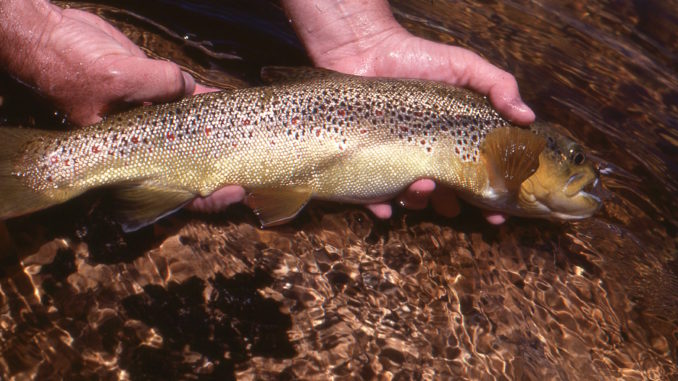
Go slow and go deep, and add mountain trout to your winter fishing resume in North Carolina.
Although few trout fishermen even pause to ponder the matter, this is a sport that has, in its own fashion, changed as dramatically in the past 50 years as turkey hunting. Just as chasing gobblers has transitioned from a fall and winter pursuit to springtime, trout fishing has expanded from a warm-weather pursuit to a year-round activity.
While the rites of opening day still hold for certain North Carolina trout waters, there are plenty of places where you can fish any day of the year. That’s a far cry from the days when trout fishing ended in late summer and didn’t resume until spring.
Another significant change in the trout fisherman’s world, one which makes late fall and early winter fishing not only possible but appealing, is suitable gear. Unless the weather is so bitter that guides on your rod are constantly freezing, there is no practical reason not to venture out. Beyond that, there are justifications aplenty for being on the water at this time of year.
For that breed apart that exclusively targets really big trout or enjoys the challenges of matching wits with them, there’s no time quite comparable to late October, November, and December. That’s thanks to brown trout making their spawning runs during the fall. Normally reclusive fish, largely nocturnal in their feeding habits and favoring habitat which old-timer Frank Young of Bryson City once described as “impossible places”, browns become much more vulnerable when they move upstream to answer the timeless pull of procreation.
During this time, they can be spotted and stalked by an observant angler. A good pair of polarized glasses will enable you to scan the water, but equally significant is the fact that brown’s redds are readily visible, and they often move into “skinny” water so shallow it scarcely covers their backs. Also, fish spending much of their year in high-country lakes answer the call to perpetuate the species and are found in streams. Much like bedding bass in the spring, browns on the move in the fall provide the optimum period for dealing with large, wild fish.
One overlooked trick for big browns is worth touching on in some detail. Several years ago, on a bitterly cold day with a skiff of snow being carried along on a penetrating breeze, I decided to go for a brisk walk on Deep Creek in the Great Smoky Mountains National Park. To my amazement I happened on a fellow with a baitcasting rig using a plug large enough to intimidate a 2-pound bass. Curious, I struck up a conversation and reminded him, in diplomatic fashion, that such lures were illegal in the Park.
“Oh no,” he responded, “not if you’ve removed one of the two sets of treble hooks and cut two of the three off the other one.” He then went on to say that while he didn’t catch a lot of fish, when he did, it was invariably a lunker brown. Proof came not five casts later when he set the hook on a golden-hued trophy that would have gone upwards of 20 inches.
The spawning period for brook trout, known as “specks” or ”speckled trout” to high-country natives, closely parallels that of browns. In the fall, these true originals of mountain waters — with both rainbows and browns being imported long ago — sport coloration that can only be described as spectacular. The males, in particular, add vivid hues of red and orange to their undersides to compliment the brilliant red dots which give them their moniker, while the females glow with gold, and the backs of both sexes turn an even darker olive/black than normal, with their white-edged fins standing out in stark contrast.
Any speck over 7 inches is a prize, and one reaching double digits is a trophy, but size is not the true measure of the joys of specks. Instead, it’s where they are found, far from the trappings of civilization, in places where man is almost an alien intruder. Their cooperative nature — hitting an angler’s offerings time and again — and the exquisite table fare they provide, outfitted in cornmeal dinner jackets, fried to a golden brown and served piping hot beside a remote campfire with fried potatoes and onion, set them apart.
And for anyone who worries about keeping fish for the pan, it should be noted that wild trout in North Carolina in general, and specks in particular, have a distinct tendency towards overpopulation. Add that consideration to their short life expectancy and fisheries biologists such as Steve Moore, who oversaw things in the Great Smoky Mountains National Park for many years, will tell you that frying a few fish has no negative impact whatsoever.
North Carolina was among the first states to experiment with the delayed-harvest concept for trout; to say that it has been a striking success would be an understatement. The original list of delayed-harvest waters grows annually, and the popularity of such streams is understandable. Regular stockings, combined with required catch-and-release regulations and use of single-hook artificials only from October until the first Saturday in June, mean ample action.
Delayed-harvest waters draw numerous non-resident anglers, and as a rule, you will be better served by being in this type of water on a weekday. Still, the nature of things — hatchery trout and abundant numbers — is such that even where you are seldom out of sight of another fisherman sport can be excellent. It’s also a fine way for a novice fisherman to get an introduction to trout with realistic expectations of having some action. A full list of all the sections of streams in the program can be found in the state fishing regulations (www.ncwildlife.org/fishing).
My personal favorites are the two sections of the Tuckasegee now open (in the Dillsboro-Sylva area and the newly opened stretch from the bridge across S 19 at Darnell Farms downstream to the lower of the two bridges crossing the river in Bryson City) and the Nantahala River. Incidentally, by the time the Tuckasegee reaches Bryson City, the power-plant releases that are a major factor upriver in Sylva aren’t much of a factor. Some of the stream is too big for wade fishing, but there are shoal areas, especially in the middle section, where the wading angler can hold his own with those fishing from boats.
As for the Nantahala, if you spend some time in the delayed-harvest section, give consideration to jumping downstream below the power-plant inflow and trying the hatchery supported section adorned with its steady hatch of canoes and kayaks when the water is on. The vast majority of the fish here are wild trout, and if I had to pick a single place in North Carolina to go with the highest likelihood of success, this would be it, never mind that one is seldom more that 50 yards from the highway.
Whether your fall angling adventures find you casting within sight of passing traffic or in some remote pool miles from the nearest road, fall and winter trout fishing has a great deal to offer. At this season, fish sometimes feed actively, especially when a bit of rain gives the water some coloration, when there’s a period on unseasonably warm temperatures stretching over several days or when bright hours of sunshine at the tail end of Indian Summer turn the world to gold. Trout sense the coming lean times of winter, and for those anglers who venture out at this season, tight lines and fine times can be your reward.

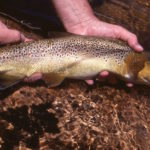
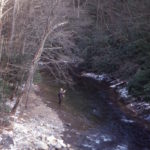
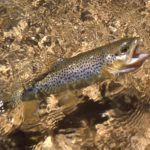
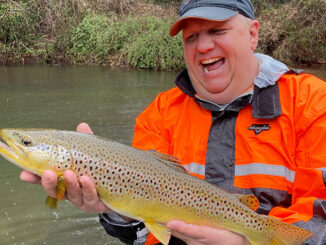


Be the first to comment